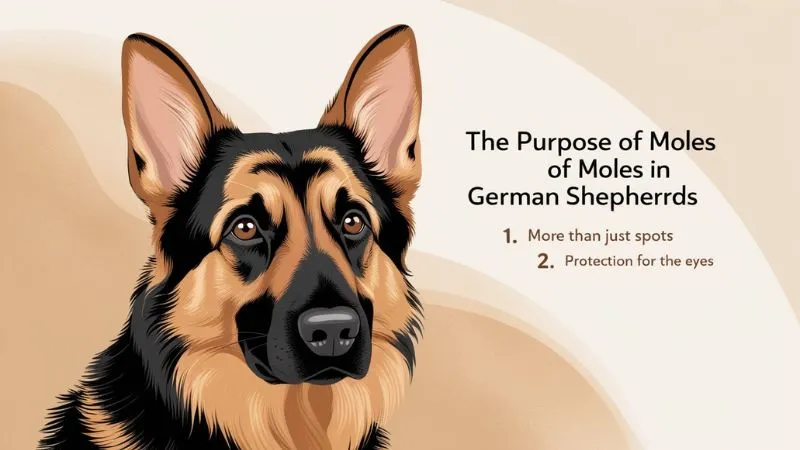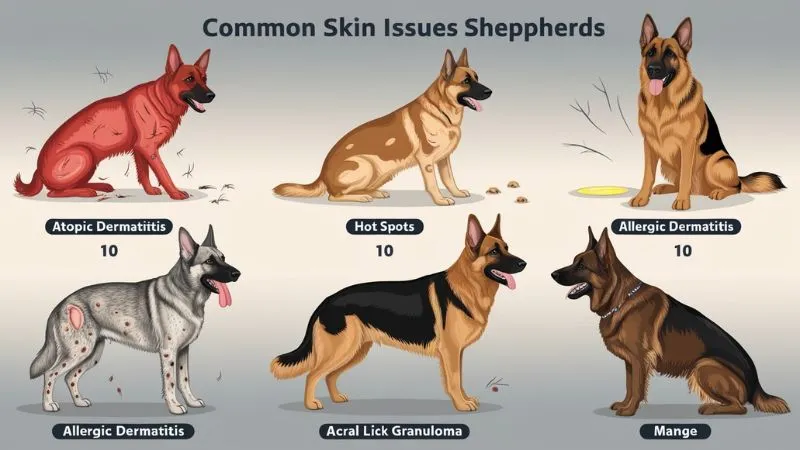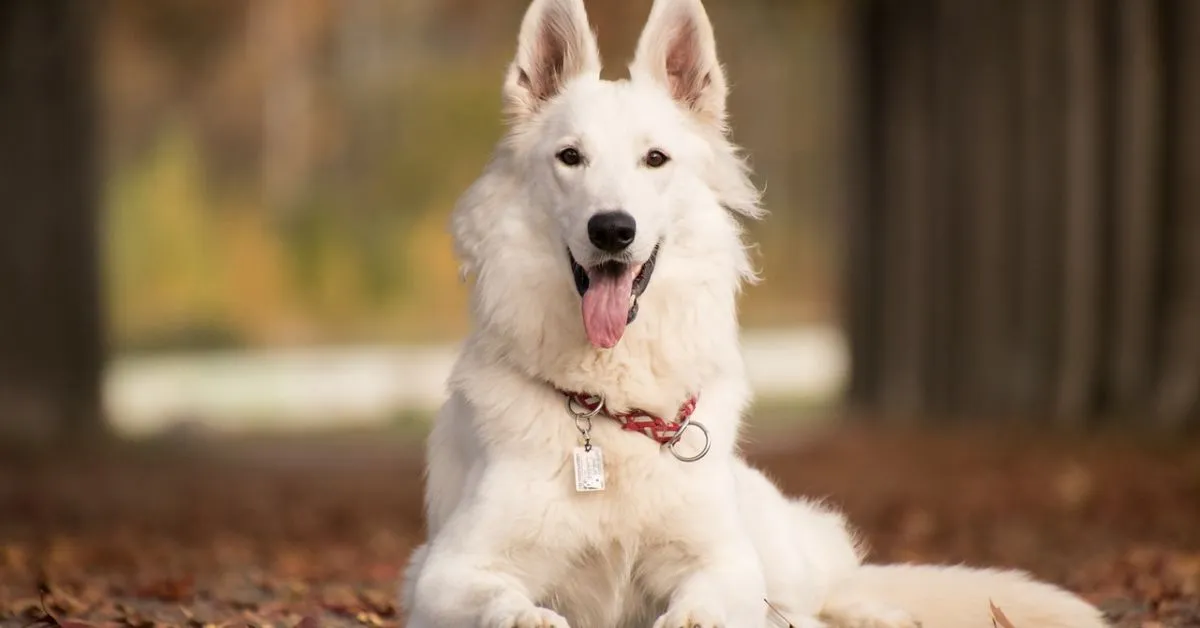German Shepherd moles are those small, dark spots you might see on their face, near the eyes and mouth. Many owners wonder why they have them. These moles are not just spots; they help your dog feel things around its face, like a sixth sense.
This can help your German Shepherd know when something is close, even if they can’t see it well. This article will examine why these moles are essential, how they help your dog, and what to know to keep them healthy. Understanding these moles can help you see why they’re special to your dog.
The Purpose of Moles in German Shepherds: More Than Just Spots

These “moles” are not moles in the traditional sense. They’re clusters of whiskers or vibrissae follicles that serve as important sensory tools for the German Shepherd. Vibrissae follicles are special types of hair follicles that are far more sensitive than regular fur. Here’s why they’re essential for the breed:
Sensory Detection
The whisker-like hairs that grow from these moles help German Shepherds detect objects and movements close to their faces. The vibrissae can sense vibrations and air movements, allowing the dog to detect potential obstacles, prey, or other items nearby without having to see them directly.
Protection for the Eyes
Since many of these vibrissae follicles are close to the eyes, they help the dog react to objects approaching their face. For example, if something is close to touching their eye, these whiskers will sense it and prompt the dog to blink or turn away, reducing the chance of injury.
Communication Tool
German Shepherds use their vibrissae and body language to communicate with each other and humans. These sensitive whiskers can help the dog react and express itself in social situations, assisting in communication with subtle movements and gestures.
The Functional Benefits of These “Moles” in German Shepherds
The distinctive moles of German Shepherds reinforce their innate working dog instincts. This breed was initially bred for herding, guarding, and other tasks that required agility and heightened senses.
A vital component of their sensory arsenal, the vibrissae follicles enable them to perceive their environment, stay vigilant, and respond rapidly. As owners of German Shepherds know, these dogs have a strong sense of loyalty and protective instincts.
These features allow them to sense and respond quickly to shifts in their environment, thanks to the vibrissa hair follicles.
For example, in a guard or companion role, these moles help them stay aware of their surroundings, making them more attuned to what’s going on and, as a result, more effective protectors.
Common Skin Issues in German Shepherds
While why German Shepherds have moles is a curiosity for some, there are other skin conditions owners need to be aware of. German Shepherds, like many other breeds, are prone to certain skin conditions. Here’s a list of the 10 most common skin issues in German Shepherds:

Atopic Dermatitis
This is a skin condition that causes inflammation and can be triggered by allergens such as pollen, dust mites, or mold. German Shepherds with atopic dermatitis often have red, itchy skin and may excessively lick or scratch themselves.
Hot Spots
Excessive licking, biting, or scratching can cause these painful, swollen skin patches. Hot spots can be triggered by allergies, insect bites, or underlying skin conditions.
Allergic Dermatitis
German Shepherds can develop allergic reactions to food, shampoos, or other environmental factors. Signs include itching, redness, and discomfort, especially around the paws, face, and ears.
Acral Lick Granuloma
This condition is characterized by persistent licking of a specific spot, often on the leg. The constant licking can lead to raw skin, hair loss, and infection.
Mange (Demodex or Sarcoptic)
Mange is caused by mites and can lead to itching, redness, and hair loss. Demodectic mange is common in puppies, while sarcoptic mange is highly contagious and can spread to humans.
Pyoderma (Bacterial Skin Infection)
Pyoderma is a bacterial infection that results in red, pus-filled sores. It can be caused by allergies, poor grooming, or even hormonal imbalances.
Follicular Dysplasia
This is a genetic condition where hair follicles do not function correctly, leading to hair loss and thinning, often around the trunk and back.
Hyperpigmentation and Hypopigmentation
Changes in pigmentation can occur due to various conditions, including hormonal changes and skin trauma. Hyperpigmentation is the darkening of the skin, while hypopigmentation is a loss of skin color.
Hair Loss (Alopecia X or Color Dilution Alopecia)
German Shepherds may experience hair loss due to genetic conditions or color dilution, where certain coat colors are more prone to alopecia.
Ectoparasite Infestations
Fleas, ticks, and lice can lead to severe itching, redness, and skin damage. These parasites are not only uncomfortable but can also carry diseases.
Understanding the Role of Skin Health in German Shepherds
Keeping a German Shepherd’s skin healthy is essential for their overall well-being. These common skin conditions can be uncomfortable, painful, and even lead to secondary infections if not treated.
Regular grooming, a balanced diet, and prompt treatment of any skin issues are crucial for a German Shepherd’s long-term health. Consulting with a vet at the first sign of skin issues is recommended, as many of these conditions can worsen without proper treatment.
How to Care for the Moles on German Shepherds

While the vibrissae follicles (or “moles”) on German Shepherds don’t require much maintenance, there are a few simple ways to care for them and ensure they stay healthy:
Regular Grooming
Brushing your German Shepherd regularly helps remove loose fur and keeps the skin clean. Avoid cutting or trimming the whisker-like hairs that come from these moles, as they play an important sensory role.
Gentle Cleaning
If the area around the moles gets dirty, a soft cloth and lukewarm water can be used to clean it. Avoid using harsh soaps or chemicals, as these can irritate the sensitive follicles.
Routine Veterinary Checkups
During regular checkups, ask your vet to examine your German Shepherd’s moles and skin condition. This can help catch any issues early and ensure that your pet remains healthy.
Balanced Diet and Hydration
A healthy diet contributes to healthy skin. Ensure your German Shepherd is on a high-quality diet that provides all essential nutrients, including omega-3 and omega-6 fatty acids, which support skin health.
Monitor for Changes
Observe your dog’s skin and the regions surrounding the moles. The best course of action is to see a veterinarian if you observe redness or swelling or if your dog starts to rub or scratch the area excessively.
The Link Between Skin Issues and “Moles” in German Shepherds
While the vibrissae follicles are a normal feature in German Shepherds, skin issues in other parts of their bodies may also impact their face and vibrissae regions. Conditions like allergic dermatitis or ectoparasite infestations can cause irritation and discomfort in the skin near the vibrissae follicles, leading to swelling, redness, or even hair loss in the areas where these “moles” are located.
For instance, in the case of atopic dermatitis, the dog’s face may become itchy or inflamed. Since the vibrissae follicles are sensitive, these areas are more prone to redness and swelling when exposed to allergens. This is why it’s crucial to be vigilant about skin issues, as any inflammation can impact these delicate follicles.
Final Thoughts: Embracing the Unique Traits of German Shepherds
Understanding why German Shepherds have moles is part of appreciating the breed’s unique characteristics. These vibrissae follicles serve an important function, contributing to the dog’s sensory perception and aiding their role as alert and protective companions.
Owners should value and care for these “moles” as essential parts of their pet’s anatomy and pay attention to any skin conditions that might affect them.
By staying informed about the common skin issues in German Shepherds, you can better support your pet’s health. Regular grooming, a balanced diet, and awareness of skin health can help maintain their comfort and overall well-being.
Whether you’re a first-time owner or a seasoned German Shepherd enthusiast, understanding these unique moles and the importance of skin health will enhance your bond with your loyal, four-legged friend.
FAQs
Why do German shepherds have a black spot?
The black spot often found on the back of a German shepherd’s neck is known as a “saddle” mark, which is a common trait due to the breed’s distinct coat color patterns. This spot is purely cosmetic and does not affect the dog’s health or behavior. It is believed to be inherited from the breed’s ancestry, where such marks helped in camouflaging and blending with their surroundings.
Why do dogs have moles?
Dogs have moles for similar reasons humans do: they are clusters of pigmented skin cells that may arise with age.
While most moles are benign, some can change over time and need monitoring for possible health issues. If a mole changes in size, shape, or color, it should be evaluated by a veterinarian to rule out any concerns.
Why do dogs have moles with whiskers?
Moles with whiskers, known as vibrissae, are sensory tools that help dogs navigate and understand their environment.
These specialized hair follicles are deeply embedded in a dog’s skin and are associated with nerves, enabling them to detect changes in air currents and nearby objects. Vibrissae are crucial for spatial awareness, especially in low-light conditions.
Do shepherds have moles?
Yes, shepherds, along with many other dog breeds, can have moles on their skin. These can appear as raised or flat growths and are usually harmless unless they begin to change in appearance. Regular veterinary check-ups can ensure that any such moles are monitored for health concerns.



